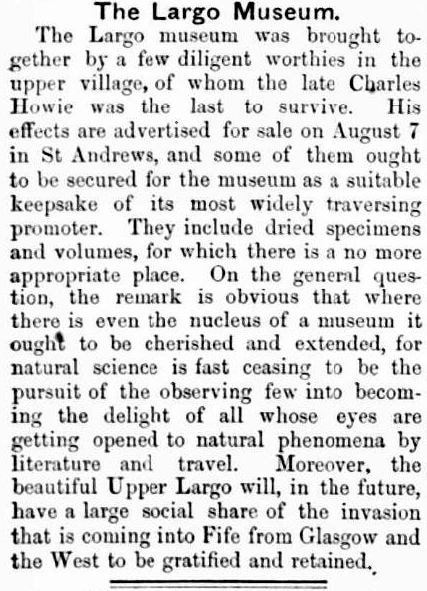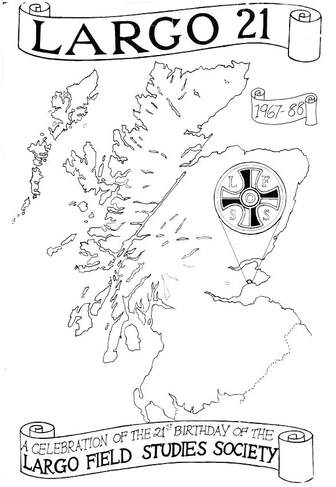Incredibly, since writing the previous two blog posts about the Largo Field Naturalists' Society, instituted in 1863, a photograph of the five founders has surfaced. The image above, of five men surrounded by plants, is part of the St Andrews University Library Special Collection. The only named man is Charles Howie (seated in the centre) and the official record only speculates on who the others in the photograph are. Taken by St Andrews photographer Thomas Rodger (1832-1883), this photo would have been taken between before 1872 (when it was displayed on the wall at a complimentary dinner in honour of Howie).
Now, to deduce who's who in the photograph. The youngest of the founding members was Benjamin Philp, Commission Agent and resident of Drummochy House. I would speculate that he is the man on Howie's right holding a smart shiny hat. To Howie's left is a dapper-looking gentleman with a trimmed collar and a floral embellishment on his jacket - likely tailor and clothier William Wood. Holding a plant stem on the far left is most probably Balcarres gardener Robert Adamson. That would leave the man on the far right in the tweed jacket as farmer James Bardner. So looking in detail at the men below, these could be from left to right: Robert Adamson, William Wood, Charles Howie, Benjamin Philp and James Bardner. Any information to help confirm this would be welcome.
After keen botanist Charles Howie retired to Upper Largo in 1862, these men, with a shared interest in the natural world, worked hard to establish their fledgling Society. In 1872 the first of the founding members was lost, when James Bardner, tenant farmer at Chesterstone died aged 55. Bardner was a well-known figure in the community, also being the first President of Largo Curling Club. Although this must have been a blow for the Society, it continued to flourish, despite having handed over the running of the annual floral fete to the newly-formed Largo Horticultural Society in 1875. The extract below from the 1877 Oliver and Boyd's New Edinburgh Almanac shows the office bearers of the Society at that time. As the previous post described, the Society opened its Museum in the old Parish School on Upper Largo's North Feus (in the foreground in the photograph below) in 1879. Just two years later, the field naturalists lost another founder - Robert Adamson, former gardener at Balcarres, who died in 1881 aged 69.
Through the 1880s, the Society's monthly meetings, annual 'conversazione' and weekly museum openings continued. The newspaper report above from 2 June 1887 Fifeshire Journal shows that both long-standing members and newer faces were actively involved. Charles Howie continued to own the museum building, leasing it to the Society, while renting Eden Cottage as his residence. However, around 1890, Charles Howie and his wife Isabella (pictured below circa 1845) moved back to St Andrews, due to failing health. Letters written by Howie during the 1890s show that he was frequently under doctor's orders to stay in bed. Yet he still tried to support the Society from a distance. He donated his collection of ferns to the museum around this time.
The early 1890s also saw the loss of two more Society founders. Benjamin Philp died in 1892 aged 72 and William Wood in 1893 aged 83. Long-distance member and long-time supporter Charles Jenner also died in 1893. Isabella Howie died in 1897 and Charles Howie himself passed away in 1899. Before his death, Howie transferred ownership of the Museum building to the Largo Field Naturalists' Society.
The piece below from the 20 November 1907 Leven Advertiser tells of how Charles Howie was "the cementing influence which bound others with less enthusiasm together" and that "with his death the activity of the Society ceased". The article goes on to say that the museum had now "for some years been little visited". It was school master Thomas Nicoll who now acted as Society Secretary and keeper of the Museum. His role was seen as "extremely nominal". At this point the future of the Society and its museum seemed bleak, however, change was afoot.
The Gilmours of Montrave had long supported the Field Naturalists and their museum. So when Sir John Gilmour provided a new public hall for Lundin Links - now known as the Montrave Hall - he ensured that it included space for a museum at the rear. The plans above show a hall capable of holding 388 adults, a stage and behind that a museum, with its own entrance to the side of the building. The contents of the Upper Largo Museum were moved to the new hall, in the growing village of Lundin Links, where greater footfall could be achieved. The old museum building was put up for sale (see below from 20 July 1910 Leven Advertiser).
In the end, the old Museum building did not sell (possibly due to legal issues connected to Howie's wishes for the building). So, the Largo Field Naturalists Society continued to own the North Feus hall. The Society, appears by this stage to have existed more or less in name only. There is no indication from the newspaper archives that they were an active organisation any longer. Within a few years the North Feus building was let to the Largo Scouts and this arrangement continued for decades.
The spirit of the old Field Naturalists was revived in 1967 when a meeting took place to form a 'Largo Field Studies Society'. The aim of this group was to stimulate interest in local surroundings, through the pursuit of archaeology, local history, geology, botany, ornithology, etc. The Society produced the book 'Largo 21' in 1988 to mark 21 years of activity and they continued for many years thereafter. Although societies may come and go, and the methods of sharing local natural history may evolve, Largo's natural and historic surroundings have perennial appeal and continue to fascinate many.













 RSS Feed
RSS Feed
